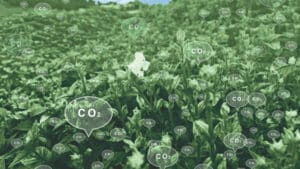During the American Seed Trade Association’s CSS & Seed Expo, experts sat down at the Seed World Media Center to talk about different issues in the sector.
Each year, hundreds of conferences are held across the globe as it pertains to the seed industry. A range of topics are covered, from economic outlooks to phytosanitary issues to new plant breeding innovations.
At most conferences, you might bump into the Seed World Media Center, where we hold interviews with experts from across the industry. It wasn’t any different at the American Seed Trade Association’s CSS & Seed Expo in Chicago, Ill., held in December 2022.
What are some of the hot-button issues that experts are interested in right now? Here’s a short compilation of what we heard while on the ground in Chicago.
The Seed Sector Needs Constant Innovation for Improvement
Over the last five decades, there’s been significant improvement in the seed sector — ranging from the creation of the first GMO in 1973 all the way up to today, where new breeding techniques, such as gene editing, are coming into perspective commercially in the industry.
Technology adaptation in the seed sector has been remarkable, says Garth Hodges, and it’s something that’s not stopping.
“Think of all the different technologies that come our way, whether it be hybridization or herbicide tolerance — these really paved the way for breeding,” Hodges, vice president of North America Business Management Seeds at BASF, says during a Giant Views interview at the American Seed Trade Association’s CSS & Seed Expo. “One of the biggest challenges I see is how to explain the art and the science of this business.”
When it comes to innovation, Hodges likes to explain it with an analogy — would you like to drive a new Mercedes or BMW, or an older version? The newer one has additional features, like power steering and different power. All those new features you’d want in cars are similar to the new features growers look for in seed traits as well.
“That’s what breeding is — constant improvement,” he says. “It’s heartwarming to see that you can be part of the initiation of this technology, see it be acquired and then see it in the field.”
And, to maintain this constant improvement and the sustainability of the seed industry, Hodges says we need to focus on interdependency.
“We can only be successful if we do things together,” Hodges says. “It’s that interdependency that really helps to strengthen what we’re doing. Once you see that there’s an appreciation for what you do and the contribution that you’re making, you’re not alone.”
Independents Look to Break into the Carbon Market
Since the Biden Administration came into office, there’s one thing on everyone’s minds, from businesses to policymakers: sustainability. Agriculture is no different, and one solution coming to mind? Participating in the carbon market with more carbon sequestration and more incentive-based programs for growers.
But, as of right now, most of the moves towards the carbon market have been made by larger, multinational companies. One question’s now arising: how can independent companies get involved in the carbon market?
“[Independents] are struggling with definition,” says Bryan Gerard, president of JoMar Seeds, during a Giant Views interview at the American Seed Trade Association’s CSS & Seed Expo.
Questions, such as: “What is the carbon program? What is the sustainability program? How do I connect that to my business? Where can I go and partner with one?” are all thoughts that Gerard has heard from his own independent customers.
“You’re an entrepreneur — you have to learn how to participate [in these programs] and utilize them to grow your business,” Gerard says.
It’s also important to keep in mind that the carbon market isn’t just a space for multinational companies.
“I often hear the comment, ‘It’s only for the big guys,’” Gerard says. “They need to flip that mindset. I think one thing that would help is that if there’s companies out there that have created sustainability that aren’t in the seed industry — partner with independent seed companies.”
In the future of sustainability and carbon markets for independent companies, Gerard thinks partnerships are going to be incredibly important.
“Licensing is a major component of our industry. Sitting down and doing things with your competitors is part of doing business now,” Gerard says. “Those collaborations are really healthy — independents just need to take that same approach and ask: ‘How do I connect? How do I integrate myself into what carbon programs are out there?’”
When Creating a Brand, It’s Important to Have a Good Story
If you’re new to the seed sector, one thing’s obvious. You need to establish a good, strong brand in order to get recognition at conferences, meetings and in the marketplace. Without a strong brand, your hard work might go unnoticed.
“A lot of the times, people think it’s hard to be the small, new player,” says Emily Negrin, vice president of corporate affairs for Inari, in a Seed World Giant Views interview at the American Seed Trade Association’s CSS & Seed Expo in Chicago. “But it’s also a great opportunity because nobody knows our story — it gives us a chance to really establish ourselves and our story.”
Though newer to the sector — at only about 6 years old — that’s exactly what Inari has been working towards: building a strong, recognizable brand with a passionate story.
But, what’s the key to building that brand and story?
Know what your ‘why’ is, Negrin says.
“What’s the purpose of your company? What’s the bigger thing that you’re driving towards?” she asks. “From there, it’s all about being able to clearly articulate that, which is sometimes the hardest part. It’s really important that you’re able to articulate your story in a quick and simple manner because all of us have short attention spans. No one wants to listen to a 30-minute answer to a simple question of what your company does.”
Instead, Negrin believes perfecting your elevator pitch is important, and keeping your story consistent. Though you might get tired of telling the same story over and over again, keeping it consistent ensures that your message is coming through properly. And remember — just because you’ve heard it a million times, doesn’t mean everyone has or remembers.
“Having that consistency builds recognition,” Negrin says.
Managing is Emotional. Here’s Some Tips to Help Out
As a first-time manager, there are a lot of questions that you may be asking. And one thing that’s really challenging? The change and transitions that come with new management.
“The most common element of any transition is recognizing that change is emotional,” says Jonathan Shaver, owner of Envision Partners in a Seed World Giant Views interview at the American Seed Trade Association’s CSS & Seed Expo. “Particularly in agriculture, the idea of an emotional transition is that we’ve built up our career or skillset to make a difference in the world in a particular way.”
When getting promoted to a new position — especially a leadership position — Shaver says this can cause a bit of a crisis. You might ask: how does this fulfill my personal mission and my intended purpose?
Often, the emotional side of a new leadership role is overlooked in favor of the strategic direction — how do you do the job and get everything done, while maintaining a similar work environment with employees?
Shaver says it’s important not to ignore the emotional side of things, and to realize it’s okay to be vulnerable with your team and management.
“The role of a leader is to lead change,” he says. “It’s worth taking time to call out and say that roles have changed. Don’t assume everybody’s going to get it — take time to talk about it.”
And, when you have questions — don’t be embarrassed to ask questions. Though being vulnerable can be tough as a new leader, being curious is never a step in the wrong direction.
“Be curious to your boss and ask: ‘How would I go about doing this?’ You truly should be curious,” Shaver says. “You should want to know how to do your job and learn new skills. Find resources to help you when you don’t know how to go about something.”
Read more Giant Views at:
When it Comes to Weed Control, Use a Program Approach, Says Greg Lammert
Jason Mize Says Growers Need New Tools for the Toolbox
According to Beni Kaufman, Genetic Markers are Changing Plant Breeding













